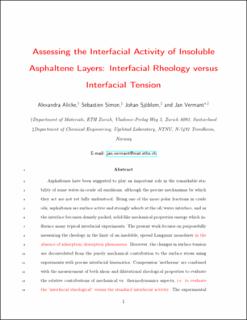| dc.contributor.author | Alicke, Alexandra | |
| dc.contributor.author | Simon, Sebastien Charles | |
| dc.contributor.author | Sjøblom, Johan | |
| dc.contributor.author | Vermant, Jan | |
| dc.date.accessioned | 2021-04-14T11:52:43Z | |
| dc.date.available | 2021-04-14T11:52:43Z | |
| dc.date.created | 2020-12-18T10:41:32Z | |
| dc.date.issued | 2020 | |
| dc.identifier.citation | Langmuir. 2020, 36 (49), 14942-14959. | en_US |
| dc.identifier.issn | 0743-7463 | |
| dc.identifier.uri | https://hdl.handle.net/11250/2737739 | |
| dc.description.abstract | Asphaltenes have been suggested to play an important role in the remarkable stability of some water-in-crude oil emulsions, although the precise mechanisms by which they act are not yet fully understood. Being one of the more polar fractions in crude oils, asphaltenes are surface active and strongly adsorb at the oil/water interface, and as the interface becomes densely packed, solid-like mechanical properties emerge, which influence many typical interfacial experiments. The present work focuses on purposefully measuring the rheology in the limit of an insoluble, spread Langmuir monolayer in the absence of adsorption/desorption phenomena. Moreover, the changes in surface tension are deconvoluted from the purely mechanical contribution to the surface stress by experiments with precise interfacial kinematics. Compression “isotherms” are combined with the measurement of both shear and dilatational rheological properties to evaluate the relative contributions of mechanical versus thermodynamic aspects, i.e., to evaluate the “interfacial rheological” versus the standard interfacial activity. The experimental results suggest that asphaltene nanoaggregates are not very efficient in lowering interfacial tension but rather impart significant mechanical stresses. Interestingly, physical aging effects are not observed in the spread layers, contrary to results for adsorbed layers. By further studying asphaltene fractions of different polarity, we investigate whether mere packing effects or strong interactions determine the mechanical response of the dense asphaltene systems as either soft glassy or gel-like responses have been reported. The compressional and rheological data reflect the dense packing, and the behavior is captured well by the soft glassy rheology model, but a more complicated multilayer structure may develop as coverage is increased. Potential implications of the experimental observations on these model and insoluble interfaces for water-in-crude oil emulsion stability are briefly discussed. | en_US |
| dc.language.iso | eng | en_US |
| dc.publisher | American Chemical Society | en_US |
| dc.relation.uri | https://pubs.acs.org/doi/10.1021/acs.langmuir.0c02234 | |
| dc.title | Assessing the Interfacial Activity of Insoluble Asphaltene Layers: Interfacial Rheology versus Interfacial Tension | en_US |
| dc.type | Peer reviewed | en_US |
| dc.type | Journal article | en_US |
| dc.description.version | acceptedVersion | en_US |
| dc.source.pagenumber | 14942-14959 | en_US |
| dc.source.volume | 36 | en_US |
| dc.source.journal | Langmuir | en_US |
| dc.source.issue | 49 | en_US |
| dc.identifier.doi | 10.1021/acs.langmuir.0c02234 | |
| dc.identifier.cristin | 1861462 | |
| dc.relation.project | Norges forskningsråd: 255174 | en_US |
| dc.description.localcode | Locked until 2.12.2021 due to copyright restrictions. This document is the Accepted Manuscript version of a Published Work that appeared in final form in [JournalTitle], copyright © American Chemical Society after peer review and technical editing by the publisher. To access the final edited and published work see https://doi.org/10.1021/acs.langmuir.0c02234 | en_US |
| cristin.ispublished | true | |
| cristin.fulltext | original | |
| cristin.qualitycode | 2 | |
